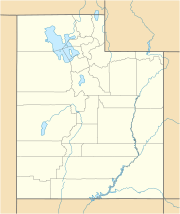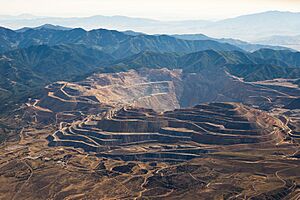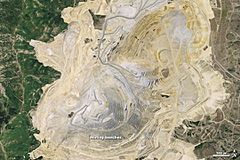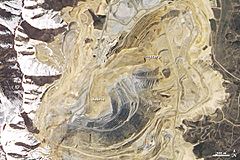Bingham Canyon Mine facts for kids
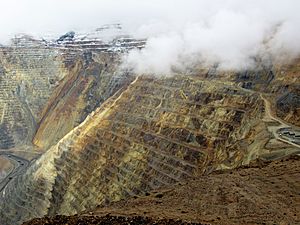
Mine in 2003
|
|
| Location | |
|---|---|
| Location | Salt Lake County |
| State | Utah |
| Country | United States |
| Coordinates | 40°31′23″N 112°09′04″W / 40.523°N 112.151°W |
| Production | |
| Products | Copper |
| Type | Open-pit |
| History | |
| Opened | 1906 |
| Owner | |
| Company | Rio Tinto Group |
|
Bingham Canyon Open Pit Copper Mine
|
|
| Lua error in Module:Location_map at line 420: attempt to index field 'wikibase' (a nil value). | |
| Area | 900 hectares |
| NRHP reference No. | 66000736 |
| Significant dates | |
| Added to NRHP | November 13, 1966 |
| Designated NHL | November 13, 1966 |
The Bingham Canyon Mine, also known as the Kennecott Copper Mine, is a huge open-pit operation. It digs up a large amount of copper from the ground. This mine is located southwest of Salt Lake City, Utah, in the Oquirrh Mountains.
It is the largest man-made hole in the world. It is also the deepest open-pit mine. Experts believe it has produced more copper than any other mine in history. Over 19 million tons of copper have come from here!
The mine is owned by the Rio Tinto Group, a big company from Britain and Australia. The copper work at Bingham Canyon Mine is handled by Kennecott Utah Copper Corporation. This company runs the mine, a plant that concentrates the ore, a smelter, and a refinery.
Mining started here in 1906. The pit is now over 0.75 miles (1.2 km) deep and 2.5 miles (4.0 km) wide. It covers an area of 1,900 acres (7.7 km²). In 1966, it was named a National Historic Landmark. The mine had a very large landslide in April 2013, and a smaller one in September 2013.
Contents
History of the Mine
Early Discoveries (1848-1863)
Copper ore was first found in Bingham Canyon in 1848. Two brothers, Sanford and Thomas Bingham, discovered it. They were Mormon pioneers who grazed their cattle there.
They told their leader, Brigham Young, about their discovery. He advised them not to mine yet. He said building settlements was more important at that time. So, the brothers focused on settling the area.
In 1850, the Bingham family moved away. But the canyon still carries their name today.
Starting Big Mining (1863-1906)
Mining for ore finally began on September 17, 1863. People started to see how much mineral wealth the canyon had. George B. Ogilvie and 23 others claimed the "West Jordan claim." Soon after, the Vidette claim was made.
At first, miners looked for gold, lead-silver, and copper-gold. But the type of copper found here, called porphyry copper, needed special processing. It also needed a railroad to move it. The railroad reached the canyon in 1873.
Enos Andrew Wall began working claims in 1887. His tunnels and test pits showed that the ore had about 2% copper.
The mines in the 1800s were quite small. But by the end of the century, very large-scale open-pit mining started. In 1896, Samuel Newhouse and Thomas Weir bought the Highland Boy Mine. It was rich in copper, silver, and gold.
They formed the Utah Consolidated Gold Mines, Ltd. with investors from England. Then they created the Boston Consolidated Gold and Copper Co., Ltd. This company worked on the lower-grade copper ore next to the Utah Copper Company site.
A major step happened in 1903. Daniel C. Jackling and Enos A. Wall started the Utah Copper Company. This company immediately began building a small processing plant in Copperton. Actual mining started in 1906.
The Utah Copper Company succeeded because of Jackling's idea in 1904. He decided to use open-pit mining, steam shovels, and the railroad. The mine became famous for its "railroad-pit operations." By 1912, the mine and the ASARCO smelting plant made it the "largest industrial mining complex in the world."
Utah Copper and Boston Consolidated merged in 1906. This happened when their separate surface mining areas grew close to each other. The Kennecott Copper Corporation bought a 25% share in Utah Copper in 1915. They increased it to 75% in 1923.
Growth and Changes (1920s-Present)
The Bingham Canyon mine grew very quickly. By the 1920s, the area was buzzing with activity. About 15,000 people from many different backgrounds lived in the canyon. They lived in large communities built on the steep canyon walls.
However, the population dropped fast as mining methods improved. Several mining towns were swallowed up by the expanding mine. By 1980, only Copperton remained. It had a population of 800 people.
In 1970, the 21 separate mining operations became just two: Kennecott and The Anaconda Minerals Company. In 1985, Kennecott stopped its open-pit mining operations. But in 1986, Kennecott found gold in nearby Barney's Canyon.
Kennecott was bought by Sohio in 1981. The mine reopened in 1987 after BP Minerals bought its assets. In 1989, the Rio Tinto Group took over. They updated the mine, the processing plant, and the smelter.
The mine owners replaced an old 1000-car railroad. They started using conveyor belts and pipelines to move ore and waste. This cut costs by almost 30% and made the mine profitable again.
Landslides at the Mine
On April 10, 2013, at 9:30 pm, a huge landslide happened at the mine. About 65 to 70 million cubic meters (85 to 92 million cubic yards) of dirt and rock slid down the pit. It might be the biggest non-volcanic landslide in North America's history.
Because the mine's steep walls were a risk, a special radar system was put in place. This system watched the ground's stability. Thanks to warnings from this system, mining operations had been stopped the day before. This meant no one was hurt.
The large slide was expected to reduce copper production by 100,000 tons (91,000 tonnes). A second, smaller slide happened on September 11, 2013. This caused 100 workers to be evacuated.
How Copper is Recovered
The ore dug from the mine goes to the Kennecott smelter in nearby Magna, Utah. First, the ore goes through a concentrator. Huge grinding machines crush it until it's as fine as face powder.
Then, a process called flotation separates the valuable metal particles from the unwanted rock (called gangue). The metal particles float to the top as a 28-percent copper concentrate. This concentrate also has smaller amounts of silver, gold, lead, molybdenum, platinum, and palladium. A special flotation step separates the molybdenite (a molybdenum mineral) from the chalcopyrite (a copper mineral).
The concentrated slurry is then piped 17 miles (27 km) to the smelter. There, it is dried and mixed with oxygen. This mixture is injected into a flash smelting furnace. This process removes iron and sulfur. The oxidized iron is skimmed off. The sulfur dioxide gas is captured and turned into sulfuric acid at a plant nearby. About a million tons of sulfuric acid are made each year.
What's left is a molten copper sulfide, called matte. This matte is 70-percent copper. It's cooled with water to form a sand-like solid. Then, it's injected with oxygen into another furnace. This furnace produces molten copper that is 98.6-percent pure. This copper is then cast into 700-pound (320 kg) anode plates. These plates are shipped by rail to the refinery.
At the refinery, the anode plates are flattened. They are placed between stainless steel cathode blanks. Robotic vehicles put these anodes into cells filled with an acidic liquid called an electrolyte. When electricity is passed through the cells, the anodes slowly dissolve. Copper ions then attach to the cathodes, forming 99.99-percent-pure copper.
Impurities and precious metals sink to the bottom of the cells. This material is called anode slime. A chlorination process recovers the gold and silver. These metals are then melted in special furnaces.
Mine Operations
Kennecott's Bingham Canyon Mine is the largest man-made hole in the world. It is even visible from space with the naked eye! About 2,000 workers are employed here. Every day, 450,000 short tons (410,000 tonnes) of material are removed from the mine.
Electric shovels can scoop up to 56 cubic yards (43 m³) or 98 short tons (89 tonnes) of ore at once. This ore is loaded into a fleet of 64 large dump trucks. Each truck can carry 255 short tons (231 tonnes) of ore. These trucks cost about $3 million each.
There is a 5-mile (8.0 km) long series of conveyors. These conveyors take the ore to the Copperton concentrator and flotation plant. The longest conveyor belt is 3 miles (4.8 km) long.
As of 2010, Kennecott Utah Copper was the second largest copper producer in the U.S. It supplied about 13-18% of the country's copper needs. It is one of the world's top copper mines. It also produces over 4 million troy ounces (124 tonnes) of silver. It makes about 10,000 short tons (9,100 tonnes) of molybdenum. And it produces about a million short tons (910,000 tonnes) of sulfuric acid. Sulfuric acid is a useful by-product of the smelting process.
Rio Tinto bought Kennecott Utah Copper in 1989. They have invested about $2 billion to modernize the operations.
The current mine plan is set to expire in 2019. Rio Tinto has been looking into a plan to make the open pit 1,000 feet (300 m) larger to the south. This would extend the mine's life into the mid-2030s. This plan depends on approval from Rio Tinto's board and about 25 environmental permits.
Mine Production
Bingham Canyon has been one of the world's most productive mines. By 2004, its ore had given more than 17 million tons (15.4 million tonnes) of copper. It also produced 23 million ounces (715 tonnes) of gold. And 190 million ounces (5,900 tonnes) of silver, plus 850 million pounds (386,000 tonnes) of molybdenum.
The value of the metals dug from Bingham Canyon Mine is more than the Comstock Lode, Klondike, and California gold rush mining areas combined. In 2005, high molybdenum prices meant the molybdenum produced at Bingham Canyon was worth more than the copper. In 2006, the value of metals produced was US$1.8 billion.
Environmental Impact
The mine has had some effects on the environment. This includes impacts on fish and wildlife. It has also caused air and water pollution. This can create health concerns for people living nearby.
Since the early 1990s, Kennecott has spent over $400 million on clean-up efforts. This helps them meet environmental rules.
Early Concerns (1900-1979)
By 1904, there were several large copper and lead smelters in the Salt Lake valley. The sulfur dioxide gas from their smokestacks damaged nearby crops. Farmers sued the smelters. In 1906, a judge ruled that smelters could not process ores with more than 10% sulfur. This effectively closed all those smelters.
Kennecott Copper Mines was formed in 1910. By 1912, environmental groups were concerned about the use of asbestos. Asbestos was used to prevent fires because copper processing needs very high temperatures. Asbestos particles could spread into the air. This caused illnesses among workers and people living near the mines.
Kennecott was also noted for releasing heavy metals like arsenic and mercury. By 1940, these were also concerns raised by environmental agencies. Both mercury and arsenic can be harmful in large amounts.
Later Environmental Issues (1980-Present)
Investigations in the 1980s found that mining operations had contaminated the groundwater. The State of Utah sued Kennecott in 1986. They claimed damages for the loss of natural resources, especially the groundwater.
There was also a concern about the tailings dam. This dam held waste materials from the mine. A report in 1988 warned that the dam, which overlooked the town of Magna, could collapse in an earthquake. If it failed, the waste pond could bury nearby homes. The company looked into ways to fix this, including buying homes or reinforcing the dam.
Starting in the early 1990s, dust from mining began to pollute surrounding areas. Levels of fine dust particles (PM10) increased. This raised health concerns for residents. In 1997, a professor suggested that the mine's dust caused lung damage to nearby residents.
In 1995, Utah passed laws requiring Kennecott to pay $37 million to control water pollution. This was because scientific research showed mining had polluted the groundwater.
Mine wastewater contained large amounts of arsenic and selenium. Selenium is especially harmful to birds, fish, and amphibians. In the early 1990s, about 30% of the fish population died. In 1995, Kennecott, the EPA, and the State of Utah agreed that Kennecott would continue to clean up the wastewater.
The EPA estimates that a 72-square-mile (190 km²) area of contaminated groundwater has been created. This is due to many spills and runoff over the years. This contamination could mean that as the population of the Salt Lake valley grows, there will be less clean underground water available.
In 2008, the United States Fish and Wildlife Service sued Kennecott. This was after hazardous substances like selenium, copper, arsenic, zinc, lead, and cadmium were released. A federal biologist stated that these chemicals had greatly harmed ecosystems and habitats for migratory birds, fish, and other wildlife.
The large southern tailings pond near Magna, Utah has been collecting waste since the mine began. Kennecott Utah Copper LLC has asked for permission to expand this pond. It is already at 1.8 billion tons capacity. They also want to expand onto 721 acres (2.92 km²) of wetlands south of the Great Salt Lake.
The company has faced questions about the dam's stability. In 2007, a newspaper reported that the company had not fully shared information about possible damage if the tailings pond collapsed during a major earthquake. From 2001 to 2009, there were six earthquakes. Their centers were only 3 miles (4.8 km) from Magna, Utah.
Images for kids
See also
 In Spanish: Mina del cañón de Bingham para niños
In Spanish: Mina del cañón de Bingham para niños


